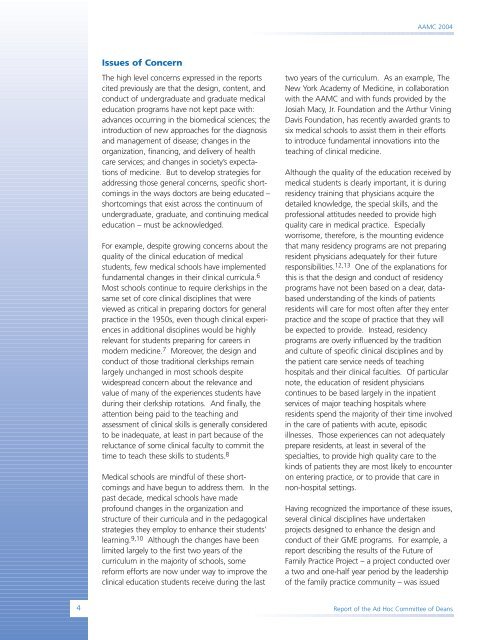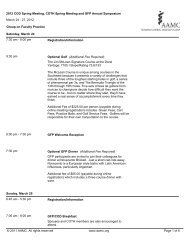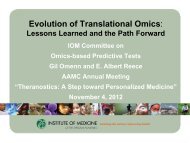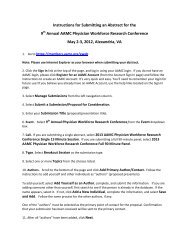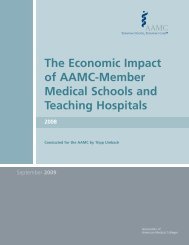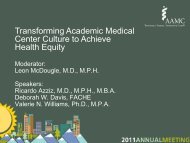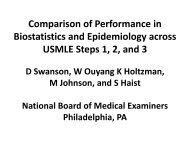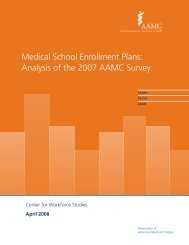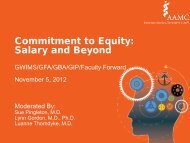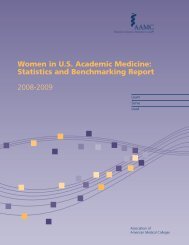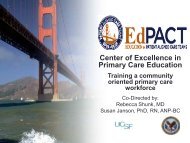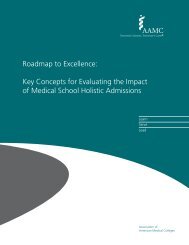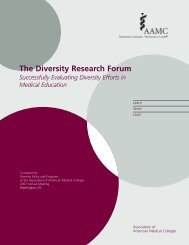Educating Doctors to Provide High Quality Medical Care - AAMC's ...
Educating Doctors to Provide High Quality Medical Care - AAMC's ...
Educating Doctors to Provide High Quality Medical Care - AAMC's ...
Create successful ePaper yourself
Turn your PDF publications into a flip-book with our unique Google optimized e-Paper software.
AAMC 2004<br />
Issues of Concern<br />
The high level concerns expressed in the reports<br />
cited previously are that the design, content, and<br />
conduct of undergraduate and graduate medical<br />
education programs have not kept pace with:<br />
advances occurring in the biomedical sciences; the<br />
introduction of new approaches for the diagnosis<br />
and management of disease; changes in the<br />
organization, financing, and delivery of health<br />
care services; and changes in society’s expectations<br />
of medicine. But <strong>to</strong> develop strategies for<br />
addressing those general concerns, specific shortcomings<br />
in the ways doc<strong>to</strong>rs are being educated –<br />
shortcomings that exist across the continuum of<br />
undergraduate, graduate, and continuing medical<br />
education – must be acknowledged.<br />
For example, despite growing concerns about the<br />
quality of the clinical education of medical<br />
students, few medical schools have implemented<br />
fundamental changes in their clinical curricula. 6<br />
Most schools continue <strong>to</strong> require clerkships in the<br />
same set of core clinical disciplines that were<br />
viewed as critical in preparing doc<strong>to</strong>rs for general<br />
practice in the 1950s, even though clinical experiences<br />
in additional disciplines would be highly<br />
relevant for students preparing for careers in<br />
modern medicine. 7 Moreover, the design and<br />
conduct of those traditional clerkships remain<br />
largely unchanged in most schools despite<br />
widespread concern about the relevance and<br />
value of many of the experiences students have<br />
during their clerkship rotations. And finally, the<br />
attention being paid <strong>to</strong> the teaching and<br />
assessment of clinical skills is generally considered<br />
<strong>to</strong> be inadequate, at least in part because of the<br />
reluctance of some clinical faculty <strong>to</strong> commit the<br />
time <strong>to</strong> teach these skills <strong>to</strong> students. 8<br />
<strong>Medical</strong> schools are mindful of these shortcomings<br />
and have begun <strong>to</strong> address them. In the<br />
past decade, medical schools have made<br />
profound changes in the organization and<br />
structure of their curricula and in the pedagogical<br />
strategies they employ <strong>to</strong> enhance their students’<br />
learning. 9,10 Although the changes have been<br />
limited largely <strong>to</strong> the first two years of the<br />
curriculum in the majority of schools, some<br />
reform efforts are now under way <strong>to</strong> improve the<br />
clinical education students receive during the last<br />
two years of the curriculum. As an example, The<br />
New York Academy of Medicine, in collaboration<br />
with the AAMC and with funds provided by the<br />
Josiah Macy, Jr. Foundation and the Arthur Vining<br />
Davis Foundation, has recently awarded grants <strong>to</strong><br />
six medical schools <strong>to</strong> assist them in their efforts<br />
<strong>to</strong> introduce fundamental innovations in<strong>to</strong> the<br />
teaching of clinical medicine.<br />
Although the quality of the education received by<br />
medical students is clearly important, it is during<br />
residency training that physicians acquire the<br />
detailed knowledge, the special skills, and the<br />
professional attitudes needed <strong>to</strong> provide high<br />
quality care in medical practice. Especially<br />
worrisome, therefore, is the mounting evidence<br />
that many residency programs are not preparing<br />
resident physicians adequately for their future<br />
responsibilities. 12,13 One of the explanations for<br />
this is that the design and conduct of residency<br />
programs have not been based on a clear, databased<br />
understanding of the kinds of patients<br />
residents will care for most often after they enter<br />
practice and the scope of practice that they will<br />
be expected <strong>to</strong> provide. Instead, residency<br />
programs are overly influenced by the tradition<br />
and culture of specific clinical disciplines and by<br />
the patient care service needs of teaching<br />
hospitals and their clinical faculties. Of particular<br />
note, the education of resident physicians<br />
continues <strong>to</strong> be based largely in the inpatient<br />
services of major teaching hospitals where<br />
residents spend the majority of their time involved<br />
in the care of patients with acute, episodic<br />
illnesses. Those experiences can not adequately<br />
prepare residents, at least in several of the<br />
specialties, <strong>to</strong> provide high quality care <strong>to</strong> the<br />
kinds of patients they are most likely <strong>to</strong> encounter<br />
on entering practice, or <strong>to</strong> provide that care in<br />
non-hospital settings.<br />
Having recognized the importance of these issues,<br />
several clinical disciplines have undertaken<br />
projects designed <strong>to</strong> enhance the design and<br />
conduct of their GME programs. For example, a<br />
report describing the results of the Future of<br />
Family Practice Project – a project conducted over<br />
a two and one-half year period by the leadership<br />
of the family practice community – was issued<br />
4<br />
Report of the Ad Hoc Committee of Deans


